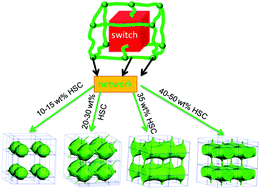Shape memory effects in shape memory polyurethane (SMPU) are due to a network architecture formed by phase separation. Here we study the phase domain architectures of a series of SMPUs by dissipative particle dynamics simulations with different hard segment contents (HSC, 4,4′-diphenylmethane diisocyanate (MDI) and 1,4-butanediol (BDO)). By simulation, an evolutionary 3D netpoint-switch-frame unit-cell model is established. With the increase of HSCs, from our simulated massive data, the MDI phase develops a framework with netpoints evolving from spheres, to linked-spheres, to linked-cylinders, and then to linked-bi-crossing-cylinders at the nanoscale, while the PCL as the switch evolves from a filling-matrix, to linked-layers, to tri-crossing-cylinders, and then to linked-bi-crossing cylinders. The BDO does not show regular shape, but acts as an inter-phase between PCL and MDI, which supports the formation of a more perfect framework. This work verifies existing data, integrates reported schematic models and extends openings for the structural and performance design of smart materials.
